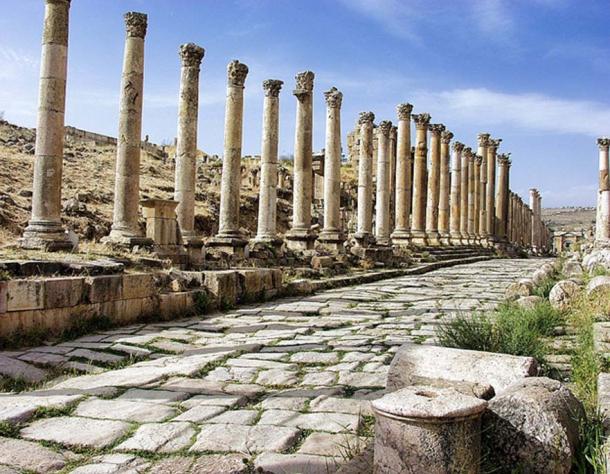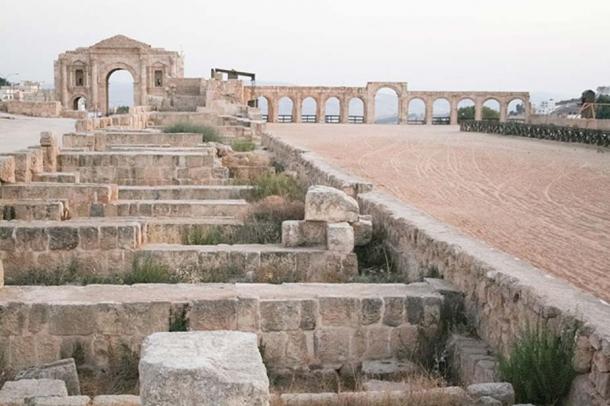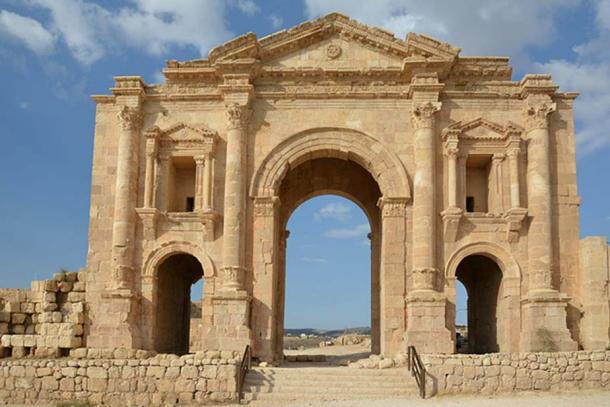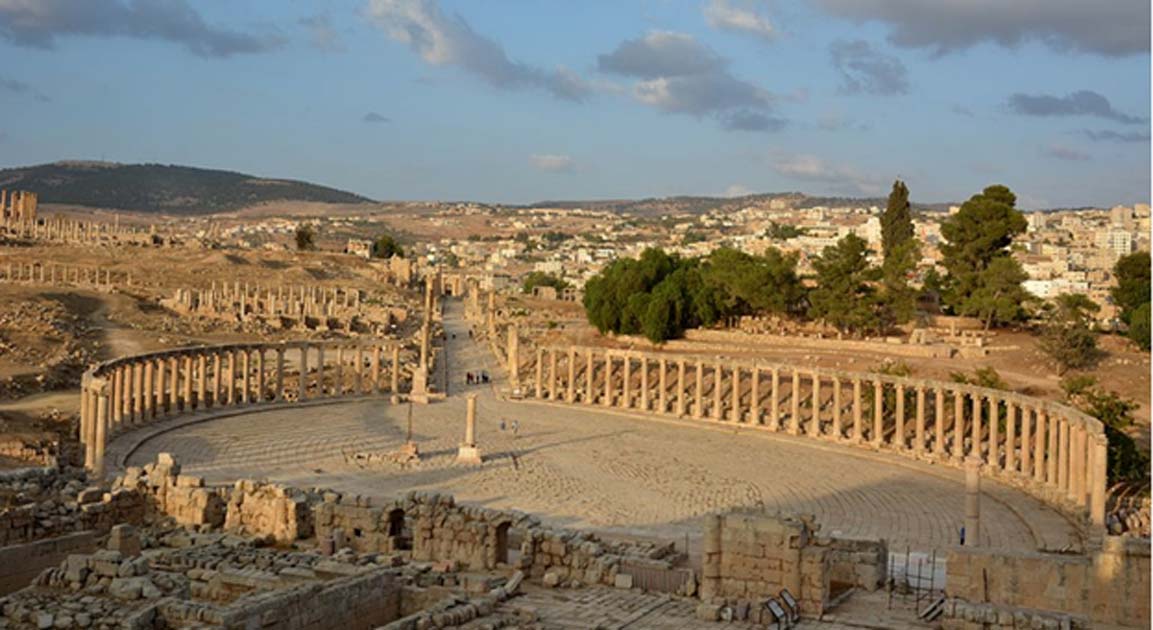Garshu, Gerasa, Jerash: the Everchanging City of the Ancient World
Today, Jerash is a relatively unimposing town in the modern-day country of Jordan but its expansive and majestic ancient ruins reveal its glorious past. Even beneath its existing ruins lies a history going back to the Neolithic Period of permanent settlement.
Jerash originated as an ancient Near Eastern village, called Garshu by its inhabitants. It later became the Greco-Roman city of Gerasa with planned and colonnaded streets, temples to Zeus and Artemis, and open-market places among other elements of Hellenistic and Roman culture. It ended its days as an Islamic city ruled by the caliphs and then the Mamluk sultans. Jerash has been an everchanging city living through many historical epochs and civilizations.

Colonnaded street in Jerash Jordan. (CC0)
Ancient Jerash
The earliest evidence of an organized, permanent settlement dates to the Neolithic. In 2017, two skulls, which could be as much as 9500 years old, were unearthed near the Jerash ruins. The earliest expression of the settlement that became Jerash was the village of Garshu. Pre-Hellenistic Garshu was inhabited by people probably related to the ancient Canaanites and Israelites. At this point, it was, at most, a small town. It passed through the hands of several Middle Eastern empires without much notice.
- Magical Incantation Discovered on Ancient Silver Scroll Written in Unknown Language
- Experts Uncover Rare Mosaics Showing Biblical Scenes in Ancient Synagogue in Galilee

A view of columns at Jerash ruins. (CC BY 2.0)
In the 4th century BC, the region surrounding Garshu was conquered by Alexander the Great. After his death in 323 BC, the southern Levant, including Garshu, eventually went to Ptolemaic Egypt. During the Hellenistic and Roman periods, the town was re-founded as the city of Gerasa. It contained multiple Greek-style temples, large public market places not unlike those in other Hellenistic and Roman cities, and at least two Greco-Roman theaters. Gerasa was also home to the Greek mathematician Nicomachus of Gerasa who wrote significant treatises on arithmetic and Neopythagorean philosophy. He lived around 100 AD.

The Hippodrome. (CC BY-SA 3.0)
Temples Amongst the Jerash Ruins
One particularly important temple in the city of Gerasa was the Temple to Artemis, built during the reign of the Emperor Antoninus Pius (138-161 AD). The temple was built on a prominent hill. The major temple for which the city is known was built during the reign of Antoninus Pius, circa 150 AD, but there is evidence of an earlier, smaller sanctuary to Artemis that existed as early as 79 AD. This indicates that the veneration of Artemis was already important in the city before the Antonine period. In addition to the temple to Artemis, there is also a temple to Zeus, another important deity in the city, to the south.
- Unexpected Statues of Mythological Goddess Unearthed in Jordan
- Mysterious Ancient Wall Extending Over 150km Investigated in Jordan

The Jerash Temple of Artemis. (CC BY 3.0)
Also, during the Roman Period, Gerasa became one of the ten cities of the Decapolis and was eventually incorporated into the Roman province of Arabia in 106 AD. It is during the Roman period that the city reached its height. There is evidence of significant Romanization as is evident from the architecture of the city and the structure of its market places which are not too different from markets in the most Romanized parts of the Empire. During the time of the late Roman Empire, Gerasa became significant as a Christian city and a Christian presence persisted in the city well into the Islamic Period.

The Arch of Hadrian, at the Southern entrance of Jerash, in Jordan. (CC BY-SA 3.0)
A City Named Jerash
It is during the Islamic Period that Gerasa became Jerash. Under the Umayyad caliphate, the city flourished as a cultural center. This was in spite of an earthquake which struck the city in the 8th century. The city began to decline in the 9th century which may have been related to the fall of the Umayyad caliphate as it was replaced by the Abbasid caliphate. The movement of the political center of the Islamic world from Damascus under Umayyads to Bagdad under the Abbasids may have affected the regional prominence of Jerash.
- 9,000-Year-Old Skeletons Found in Jordan had been Dismembered, Sorted, and Buried in Homes
- Set of 70 Metal Tablets May Have the Earliest Written Account and Depiction of Jesus

Inscriptions at Jerash, Jordan. (CC BY-SA 4.0)
Jerash in Ruins
In the 12th century, the city became implicated in the conflicts between the Christian Crusader states and the surrounding Islamic principalities. In 1121, King Baldwin II of Jerusalem sacked the city because it was the location of an enemy garrison and fortifications. In addition to the city being mostly destroyed, the Temple of Artemis was damaged. The damage from the fire is still apparent on the walls of the ruins of the Temple. After the crusades, the region surrounding Jerash came under the control of the Mamluk sultanate. During this period, parts of the city were resettled and continued to be inhabited until the 16th century, but after the 16th century, Jerash was completely deserted and forgotten to history, not to be recovered until archaeological excavations began in the 19th century.

North Theater, Jaresh. (CC BY-SA 3.0)
The city of Jerash went through many changes during its long existence, going from a Semitic village to a Greco-Roman metropolis, and eventually to an Arabized metropolis. The city however remained inhabited and was able to adapt to each epoch in which it found itself. It is for this reason that it could be considered an everchanging city. This quality of Jerash was not infinite though. The city was eventually destroyed and abandoned as all cities may be eventually, even ones that are prosperous today like New York, London, or Singapore.
Top image: The Oval Forum and Cardo Maximus in ancient Jerash. (CC BY-SA 3.0)
By Caleb Strom
References
Uscatescu, Alexandra, and Manuel Martín-Bueno. "The Macellum of Gerasa (Jerash, Jordan): from a market place to an industrial area." Bulletin of the American Schools of Oriental Research (1997): 67-88.
Raja, Rubina. The sanctuary of Artemis in Gerasa. Vol. 12. Museum Tusculanum Press, 2009.
Retzleff, Alexandra, and Abdel Majeed Mjely. "Seat inscriptions in the Odeum at Gerasa (Jerash)." Bulletin of the American Schools of Oriental Research (2004): 37-48.
McDermott, William C. "Plotina Augusta and Nicomachus of Gerasa." Historia: Zeitschrift für Alte Geschichte H. 2 (1977): 192-203
Gawlikowski, Michael. "Jerash in early Islamic times." Oriente moderno 23.2 (2004): 469-476.
Murray, Alan V. "Baldwin II and his nobles: Baronial factionalism and dissent in the kingdom of Jerusalem, 1118-1134." Nottingham Medieval Studies 38 (1994): 60-85
“Danish-German archaeological project in Jerash ‘unlocks new path to understanding the city’” Saeb Rawashdeh (2017). The Jordan Times. Available at: http://www.jordantimes.com/news/local/danish-german-archaeological-project-jerash-unlocks-new-path-understanding-city%E2%80%99
“Two human skulls dating back to Neolithic period unearthed in Jerash” by Dana Al Emam (2015). The Jordan Times. Available at: http://www.jordantimes.com/news/local/two-human-skulls-dating-back-neolithic-period-unearthed-jerash



















